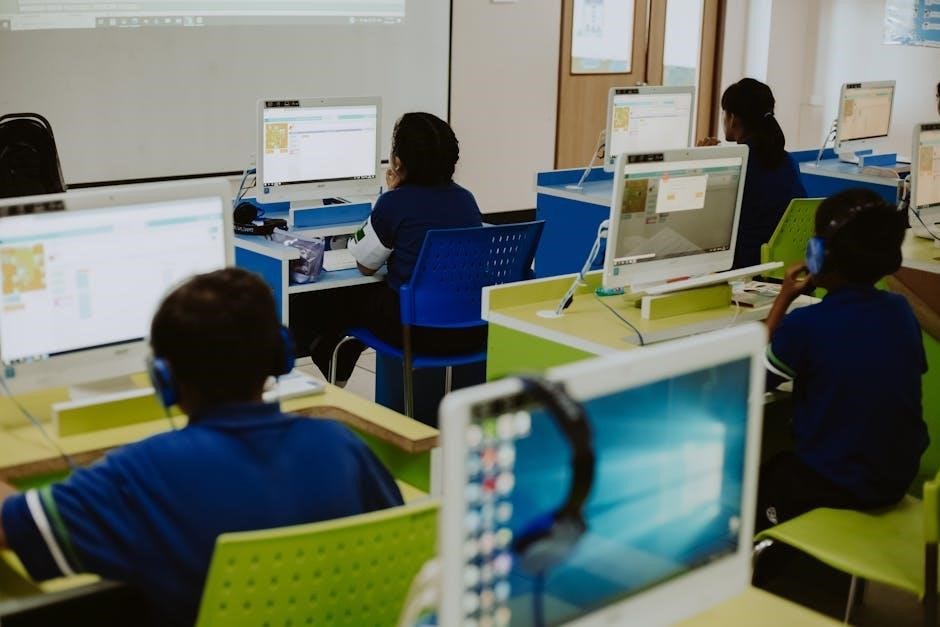
Implicit instruction refers to the process of learning through indirect methods, where knowledge is absorbed naturally without explicit explanations or direct teaching․
It relies on contextual cues, environmental interactions, and subtle guidance, allowing learners to deduce concepts through experience and observation rather than structured lessons․
This approach emphasizes subconscious processing, making it a powerful tool for fostering intuitive understanding and long-term retention of skills and information․
1․1 Definition of Implicit Instruction
Implicit instruction is a learning approach that emphasizes indirect methods of knowledge acquisition, where concepts are conveyed through context, observation, and environmental cues rather than explicit explanations․
It involves subtle guidance, allowing learners to deduce information naturally, often subconsciously, through experiences and interactions․ This method contrasts with explicit instruction, which relies on direct teaching and structured explanations, fostering intuitive understanding and passive learning․
Implicit instruction is particularly effective in promoting active engagement and long-term retention, as it encourages learners to connect new information to existing knowledge and experiences․
1․2 Importance of Implicit Instruction in Learning
Implicit instruction is crucial for fostering natural, intuitive learning experiences that align with real-world scenarios, where information is often acquired indirectly․
By reducing reliance on explicit explanations, it minimizes cognitive overload, allowing learners to focus on contextual understanding and practical application․
This approach enhances long-term retention, as concepts are absorbed through experience and observation, making them easier to recall and apply in diverse situations․
It also promotes active engagement, encouraging learners to connect new information to their existing knowledge base, fostering a deeper and more meaningful understanding of the material․
1․3 Historical Background of Implicit Instruction
Implicit instruction has its roots in early 20th-century educational psychology, emphasizing indirect learning through environmental cues and natural experiences․
The concept gained traction with researchers like Albert Einstein, who valued intuitive understanding over rote memorization, and Jean Piaget, who highlighted the role of active discovery in learning․
In the mid-20th century, studies on subconscious processing further solidified its theoretical foundation, showcasing how indirect methods foster deeper comprehension and retention․
Today, implicit instruction is widely recognized as a complement to explicit teaching, particularly in fostering creativity, critical thinking, and practical application of knowledge․

Key Characteristics of Implicit Instruction
Implicit instruction involves indirect learning strategies, subtle cueing techniques, and a focus on contextual understanding, fostering intuitive knowledge acquisition through environmental interactions and subconscious processing․
2․1 Indirect Learning Strategies
Indirect learning strategies in implicit instruction involve presenting information in a non-didactic manner, encouraging learners to absorb knowledge through environmental cues and real-world examples․
Learners are guided to discover concepts naturally, often through observation, self-directed exploration, and subtle hints, rather than direct explanations or structured lessons․
This approach fosters engagement and passive learning, allowing individuals to internalize information without explicit instruction, making it a powerful method for intuitive skill development and understanding․
2․2 Subtle Cueing Techniques
Subtle cueing techniques are essential in implicit instruction, utilizing non-verbal or understated prompts to guide learners toward understanding concepts without overt direction․
These cues may include gestures, facial expressions, or contextual arrangements, allowing learners to infer meaning through their environment and experiences․
Such techniques encourage active interpretation and reduce reliance on explicit instructions, fostering a more natural and intuitive learning process․
2․3 Focus on Contextual Understanding
Implicit instruction emphasizes learning within meaningful contexts, where information is presented in relation to real-world scenarios or practical applications․
By embedding learning in relevant environments, learners develop a deeper understanding of concepts through their natural connections and relationships․
This approach enhances comprehension and retention by making learning intuitive and aligned with how knowledge is typically acquired in real life․

Applications of Implicit Instruction
Implicit instruction is widely applied in educational settings, workplace training, language learning, and bias mitigation, enhancing learning through indirect methods tailored to diverse needs․
3․1 In Educational Settings
In educational settings, implicit instruction is used to foster a deeper understanding of concepts through contextual learning experiences rather than direct teaching․ Teachers employ subtle cueing techniques, such as guided discovery and modeling, to encourage students to infer knowledge from their environment․ This approach aligns with how students naturally absorb information, making it particularly effective in subjects like language arts and sciences․ By focusing on real-world applications, educators help students develop critical thinking and problem-solving skills without explicit instruction․ This method promotes long-term retention and intuitive learning․
3․2 In Workplace Training
Implicit instruction is increasingly valued in workplace training for fostering intuitive skill development․ Employers use subtle cueing techniques, such as modeling and guided discovery, to help employees learn through observation and hands-on experience․ This approach aligns with natural learning processes, enhancing problem-solving and adaptability․ By immersing trainees in real-world tasks, organizations promote long-term retention of skills and intuitive decision-making․ Implicit instruction reduces reliance on explicit directives, enabling employees to adapt seamlessly to dynamic work environments and complex challenges, making it a powerful tool for modern workplace development․
3․3 In Language Learning
Implicit instruction plays a vital role in language learning by fostering natural acquisition through contextual exposure․ Learners absorb linguistic patterns subtly, mimicking native speakers and interpreting meanings from real-life interactions․ This method emphasizes intuitive understanding over explicit rules, enhancing vocabulary retention and grammatical accuracy․ By immersing students in authentic scenarios, implicit instruction replicates how children learn their first language, promoting fluid communication and cultural sensitivity․ It reduces reliance on memorization, encouraging learners to grasp language nuances subconsciously, making it an effective approach for developing practical language proficiency․
3․4 In Bias Mitigation and Sensitivity Training
Implicit instruction is increasingly used in bias mitigation and sensitivity training to address unconscious prejudices․ By exposing individuals to diverse perspectives subtly, this method helps recognize and reduce implicit biases without direct lectures․ Techniques like scenario-based learning and case studies encourage introspection, fostering empathy and inclusive behaviors․ This approach leverages subconscious processing to internalize sensitivity, promoting cultural competence and reducing discriminatory actions․ It creates a non-confrontational environment for self-reflection, making it an effective tool for fostering inclusive attitudes and behaviors in both personal and professional settings․

Psychological Foundations of Implicit Instruction
Implicit instruction relies on subconscious processing, reducing cognitive load and enhancing long-term memory retention by embedding learning within natural, contextual experiences․
4․1 Role of Subconscious Processing
Implicit instruction heavily relies on subconscious processing, where information is absorbed naturally through environmental cues and real-world experiences․
This method bypasses conscious awareness, allowing learners to internalize knowledge effortlessly, often without realizing they are acquiring new skills or understanding․
Such processing reduces cognitive strain, making learning more efficient and intuitive, as the brain processes information in a more organic and less forced manner․
4․2 Impact on Cognitive Load
Implicit instruction reduces cognitive load by minimizing the need for active, conscious processing of information․
By presenting learning opportunities through natural contexts and indirect cues, it prevents mental overload, allowing learners to absorb knowledge more smoothly․
This approach aligns with how the brain naturally processes information, promoting efficient learning and retention without the stress of direct, structured instruction․
4․3 Connection to Long-Term Memory Retention
Implicit instruction enhances long-term memory retention by embedding learning in real-world contexts and experiences․
Through indirect exposure and natural discovery, information is stored more effectively in long-term memory compared to explicit methods․
This approach leverages the brain’s ability to retain knowledge acquired subconsciously, making it easier to retrieve and apply in practical situations․

Techniques Used in Implicit Instruction
Implicit instruction employs methods like modeling, guided discovery, and scaffolding to facilitate natural, intuitive learning without direct explanations․
5․1 Modeling and Observation
Modeling and observation are cornerstone techniques in implicit instruction, where demonstrators perform tasks or behaviors without explicit explanations, allowing learners to absorb patterns through observation․ This method leverages the psychological tendency to mimic and internalize actions within a supportive environment․ By focusing on practical examples rather than verbal instructions, learners develop intuitive understanding and skill retention through indirect exposure․ This approach aligns with the principles of contextual learning, fostering natural acquisition of knowledge and behaviors․
5․2 Guided Discovery
Guided discovery is an implicit instructional technique where learners explore concepts through structured yet open-ended activities, guided by subtle prompts and questions․ This method encourages critical thinking and problem-solving by allowing learners to uncover knowledge independently, with minimal direct instruction․ By fostering self-directed learning, guided discovery enhances retention and understanding, as learners connect new information to their existing knowledge base․ This approach is particularly effective in complex or ambiguous subjects, where learners benefit from gradual, intuitive insight into the material․
5․3 Scaffolding Techniques
Scaffolding techniques involve providing temporary, structured support to learners, enabling them to build upon prior knowledge and gradually master complex tasks independently․ These techniques are integral to implicit instruction, as they guide learners through the learning process without explicit direction․ By offering hints, visual aids, or prompts, scaffolding helps bridge gaps in understanding, allowing learners to progress at their own pace․ As learners gain proficiency, the support is systematically reduced, fostering autonomy and deepening comprehension of the material․

Challenges in Implementing Implicit Instruction
Implicit instruction faces challenges such as limited awareness among educators, difficulty in measuring effectiveness, and variability in learners’ cultural and individual learning styles․
6․1 Limited Awareness Among Educators
Many educators remain unfamiliar with implicit instruction due to its subtle nature, often overshadowed by explicit teaching methods․ Traditional training frequently emphasizes direct instruction, leaving little room for exploring indirect approaches․ This lack of awareness limits the adoption of implicit techniques in classrooms․ Additionally, educators may struggle to recognize the value of subconscious learning processes, particularly when measuring outcomes becomes challenging․ As a result, the potential benefits of implicit instruction, such as fostering critical thinking and problem-solving, are often overlooked in favor of more structured, measurable approaches to education․
6․2 Difficulty in Measuring Effectiveness
Assessing the impact of implicit instruction is challenging due to its indirect nature․ Unlike explicit methods, where outcomes are easily quantifiable, implicit learning often occurs subconsciously․ Traditional assessments, such as tests or quizzes, may fail to capture the gradual, intuitive understanding developed through contextual experiences․ This makes it difficult to establish clear benchmarks for success․ Additionally, the subtle and often uneven progression of implicit learning complicates the measurement process, requiring innovative evaluation strategies to accurately gauge effectiveness․
6․3 Cultural and Individual Variability in Learning Styles
Cultural and individual differences in learning preferences pose challenges for implicit instruction․ Learners from diverse backgrounds may interpret subtle cues differently, affecting their ability to absorb information indirectly․ Additionally, some individuals thrive in structured environments, while others prefer intuitive, self-guided approaches․ These variations require educators to adapt implicit instruction methods to accommodate different learning styles, ensuring that all participants can engage effectively․ This variability underscores the need for flexible strategies to maximize the benefits of implicit learning across diverse groups․

Real-World Examples and Case Studies
Successful implementations of implicit instruction are evident in corporate training and classroom settings, where indirect learning strategies enhance skill acquisition naturally and effectively․
7․1 Successful Implementation in Classroom Settings
Classrooms leveraging implicit instruction often employ indirect learning strategies, such as modeling and guided discovery, to foster intuitive understanding․
Teachers use contextual cues and real-world scenarios, allowing students to deduce concepts naturally, enhancing engagement and retention without direct explanations․
For instance, in language arts, students might infer grammar rules through reading and writing exercises, while in science, hands-on experiments encourage implicit learning of complex principles․
This approach aligns with psychological principles, promoting subconscious processing and long-term memory retention, making it a valuable method in modern education․
7․2 Applications in Corporate Training Programs
Corporate training programs increasingly adopt implicit instruction to enhance employee skills through indirect learning methods, fostering intuitive understanding and practical application․
Subtle cueing techniques, such as modeling and guided discovery, are used in leadership development, where employees learn by observing experienced leaders and participating in real-world scenarios․
In bias mitigation, implicit instruction helps employees recognize and address subconscious biases through contextual exercises and group discussions, promoting a more inclusive workplace culture․
This approach not only improves cognitive retention but also equips employees with adaptable skills, making it highly effective for modern workplace training needs․

Future Trends in Implicit Instruction
Future trends include integrating AI for personalized learning, leveraging neuroscience for optimized subconscious processing, and enhancing digital platforms with dynamic, intuitive instructional designs․
8․1 Integration with Artificial Intelligence
Artificial intelligence (AI) is poised to revolutionize implicit instruction by personalizing learning experiences through adaptive algorithms that detect and respond to individual needs․
AI-driven systems can analyze learner behavior, offering subtle cues and tailored scenarios to enhance contextual understanding without direct instruction․
Additionally, AI tools like chatbots and virtual assistants can simulate real-world interactions, enabling learners to absorb knowledge naturally through practice and exploration․
This integration promises to make implicit instruction more accessible, efficient, and aligned with modern technological advancements in education and training;
8․2 Role of Neuroscience in Advancing Implicit Instruction
Neuroscience plays a pivotal role in advancing implicit instruction by uncovering how the brain processes information subconsciously․ Studies reveal that implicit learning engages distinct neural pathways, enhancing skill acquisition and memory retention without conscious effort․ By understanding these mechanisms, educators can design instruction that aligns with the brain’s natural learning processes․ Neuroimaging techniques have helped identify brain regions involved in implicit processing, enabling more effective instructional strategies․ This connection between neuroscience and implicit instruction fosters deeper understanding and improves learning outcomes․
8․3 Increasing Adoption in Digital Learning Platforms
Digital learning platforms are increasingly incorporating implicit instruction to enhance engagement and effectiveness․ These platforms use interactive simulations, AI-driven adaptive learning, and gamification to create immersive environments where learners acquire knowledge naturally․ By leveraging implicit learning principles, digital tools can reduce cognitive load and promote intuitive understanding․ The integration of real-world scenarios and contextual cues further supports this approach․ As technology evolves, the adoption of implicit instruction in digital learning platforms is expected to grow, offering personalized and impactful learning experiences for diverse audiences․

Best Practices for Effective Implicit Instruction
Effective implicit instruction involves creating engaging, relevant scenarios that align with learner needs, leveraging technology to enhance contextual understanding, and fostering a supportive, intuitive learning environment․
9․1 Aligning Instruction with Learner Needs
Aligning implicit instruction with learner needs involves tailoring the learning environment to individual preferences and skill levels, ensuring relevance and engagement․ Assessing prior knowledge and adapting cues and contexts to match learner abilities enhances effectiveness․ Real-world analogies and culturally sensitive examples help bridge gaps, making instruction more relatable․ Incorporating feedback mechanisms allows for continuous refinement, ensuring learners remain on track․ This personalized approach fosters deeper understanding and retention, making implicit instruction more impactful and meaningful for diverse learners․
9․2 Creating Engaging and Relevant Scenarios
Creating engaging and relevant scenarios in implicit instruction involves designing real-world contexts that align with learners’ experiences and interests; Authentic, job-specific situations or relatable challenges encourage active participation and intuitive learning․ Incorporating interactive elements, such as role-playing or problem-solving tasks, enhances engagement․ Cultural sensitivity and diverse perspectives ensure scenarios resonate with all learners․ By simulating practical applications, implicit instruction fosters deeper understanding and skill retention, making learning feel natural and meaningful․
9․3 Leveraging Technology for Enhanced Learning
Technology plays a vital role in enhancing implicit instruction by providing interactive and immersive learning experiences․ AI-driven platforms adapt content to individual needs, offering personalized learning paths․ Virtual simulations and gamification elements engage learners through intuitive tasks, fostering skill development naturally․ Integrating tools like chatbots and interactive videos supports contextual understanding, making abstract concepts more relatable․ Additionally, data analytics help educators track progress and refine their methods, ensuring effective and tailored implicit learning experiences for all learners․
Implicit instruction emphasizes indirect learning through contextual understanding and subconscious processing, fostering long-term retention and intuitive skill acquisition while balancing structured guidance with natural discovery․
10․1 Summary of Key Points
Implicit instruction involves indirect learning through contextual cues and subconscious processing, fostering intuitive understanding and long-term retention․ It emphasizes environmental interactions and subtle guidance, allowing learners to deduce concepts naturally․ This approach reduces cognitive load and enhances retention by engaging learners in real-world scenarios․ Effective in educational and workplace settings, implicit instruction promotes self-discovery and practical application of skills․ By balancing structured guidance with autonomous exploration, it encourages deeper comprehension and adaptability, making it a valuable method for diverse learning environments and objectives․
10․2 Implications for Future Learning Strategies
Implicit instruction offers significant potential for shaping modern learning strategies by integrating AI, neuroscience, and digital platforms․ Its focus on indirect learning aligns with the growing need for personalized and adaptive education․ By leveraging contextual understanding and subconscious processing, future strategies can enhance engagement and retention․ The approach also supports scalability, making it ideal for diverse learning environments․ As technology advances, implicit instruction could become a cornerstone of innovative, learner-centered educational systems, fostering deeper comprehension and practical skill application across various disciplines․
10․3 Encouraging Further Exploration and Research

Further exploration of implicit instruction is essential to unlock its full potential in education and training․ Research should focus on understanding its long-term effects, optimal implementation methods, and cultural adaptability․ By examining real-world applications and refining techniques, educators can enhance learning outcomes․ Encouraging interdisciplinary studies, particularly with neuroscience and AI, could reveal innovative strategies to improve subconscious learning processes․ Continued investigation will ensure implicit instruction remains a dynamic and effective approach in evolving educational landscapes, addressing diverse learner needs and fostering inclusive environments for sustainable growth․